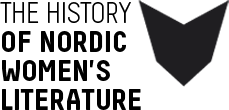Ingeborg Stuckenberg saw Johannes Jørgensen’s, Helge Rode’s, and Viggo Stuckenberg’s renouncement of the Modern Breakthrough as a betrayal of everything they had believed in and fought for. She had inspired, critiqued, composed music for her friends’ poems, and written texts for her husband’s literary output. And yet she had no opportunity for countering their deceit. No, she would not be muse, not priestess, not Valkyrie for others – she would be her own soldier.She saw no prospect of being this in turn-of-the-century Denmark. In the spring of 1903, she left everything behind, went to Bremen, and boarded an emigrant ship bound for New Zealand. The following year, on 12 August 1904, she committed suicide, thirty-eight years old.
Articles
The bohemian authors aspired to a sense of life and art that could break open the boundaries both for oppressive bourgeois respectability and fatuous modernity. This applied to the women of the bohemia as well. But for them, freedom and liberation were not synonymous with the feminists’ demand for the right to vote, but a question of self-realisation in love and art.If the male figure-heads of the bohemian milieu caused scandal, the women did too – and to no less a degree. As bohemians they offended against every norm of what constituted a decent life for a woman as wife, as mother, as the heart and mind of the home. At the same time, it was for this femininity that they were fetishised in the bohemian milieu.
On the threshold to the twentieth century, the doors to the world stood open. At last the individual had the prospect of liberation from the restrictive bindings of religion, class, and gender. With the new world picture as its mental sounding board, the new century opened up for a progressive process of integration.Women and ordinary people gained access to bourgeois written culture, and they then of course made their mark on this culture.While male writers and scientists were shoring up their threatened masculinity by categorising “Woman” under “primordial Nature”, the women were surely and steadily gaining ground in the men’s bastions of power.
New Faroese Women’s Literature
The few Icelandic women writers to appear around the turn of the twentieth century travel from the countryside to Reykjavík. But it is not contemporary Iceland that frames, in their literary works, their depiction of Icelandic women’s struggles of the modern age.They choose the past as a time frame, the journey back to the patriarchal farming community from which the contemporary identity conflicts and attempted exoduses spring. From this perspective, they thematise the conflicts between duty and freedom and the ambivalence concerning women’s new liberation.
Gender and Class in Icelandic Women’s Literature of the 1970s
The start of the 1960s saw the publication of the first poetry collection by Vilborg Dagbjartsdóttir who, as a modernist and a multifaceted cultural figure, has inspired both a younger generation of Icelandic female poets and poets of her own generation.Poets such as Þóra Jónsdóttir, who made her debut in 1973, and Þuríður Guðmundsdóttir, who published her first book in 1969, were, like Vilborg Dagbjartsdóttir, born and brought up in the countryside, and later settled in Reykjavík, and they are, to some extent, preoccupied with the same poetic subjects. They express themselves in precisely chiselled, minimalist poems that demand the reader’s full attention.
Icelandic writer Svava Jakobsdóttir’s fantastical narratives are witty, their humour and irony emerging not least from their intertextual dialogues. The Bible acts as something of an internal text within her entire oeuvre, but she also refers to world literature, myths, adventures, and women’s magazines. Her epic texts are at their most gruesome and grotesque when she tackles traditional clichés and stock phrases, which people use without thinking: ‘sacrificing oneself’, ‘giving someone a hand’.Svava Jakobsdóttir’s oeuvre is often divided into two parts, the realistic and the fantastical, and it is the fantastical stories that have attracted the most attention. This division, however, is a simplification of Svava Jakobsdóttir’s radical project. She has, in fact, never rejected the realistic art of storytelling, or its social and political references.
Icelandic writer Ásta Sigurðardóttir had a fondness for self-presentation that took her contemporaries’ breath away. All her short stories reflect a tension between, on the one hand, the longing for normality, security, and bourgeois acceptance and, on the other hand, rebellion, a need for freedom, and a deep-seated rejection of bourgeois values.She loved to perform, but no-one else should write her roles for her. Journeying is a recurrent motif in Ásta Sigurðardóttir’s texts, and her characters are alone, in both a physical and an existential sense. Her late texts lack the intensity that characterised her first short stories. The pride, the self-assertion, the queenly arrogance are gone. The gaze is dull, self-hatred is dominant. There is no longer anything worth describing.
A single woman, Arnfríður Jónatansdóttir, ought to be counted among the modernist group of Icelandic writers known as the Atom Poets. Her poems display the same characteristics: they are written in free form, in a concentrated language, and she makes free use of imagery.Before the emergence of the Atom Poets numerous other poets had straddled the divide between tradition and innovation, and many female poets had merged the old and the new in their poetry. This holds true of authors such as Sigríður Einars frá Munaðarnesi and Halldóra B. Björnsson. But the positioning of them, within Icelandic literary history is not a straightforward matter, and this problem illustrates their poetic conflicts.It is as though they are, themselves, in doubt about their position; they want to prove themselves within a tradition to which they do not, in fact, belong, and they are at the same time filled with enthusiasm for the free-form poetry. They gave themselves whole-heartedly to the new, liberated poetry after having demonstrated, in their debuts, their mastery of the traditional craft – rhyming, alliterative poems in a strict, rhythmical form.

